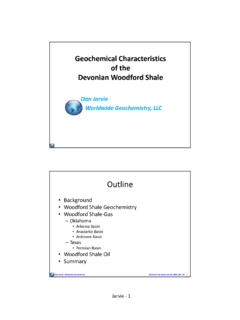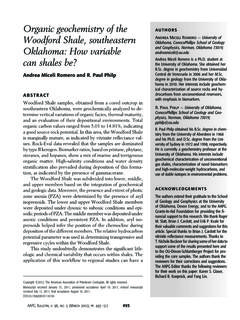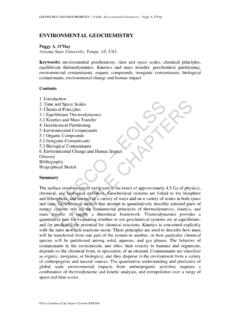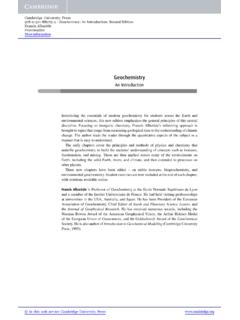Transcription of Petroleum Geochemistry
1 UNESCO EOLSSSAMPLE CHAPTERSPETROLEUM ENGINEERING UPSTREAM - Petroleum Geochemistry - Giovanni Martinelli Encyclopedia of Life Support Systems (EOLSS) Petroleum Geochemistry Giovanni Martinelli ARPA, Environmental Protection Agency of the Emilia Romagna Region, Reggio Emilia, Italy Keywords: Organic Geochemistry ; Oil composition; Kerogen; Oilfield waters; Trace elements; Isotopes; Noble gases; Geochemical prospection. Contents 1. Introduction 2. Geochemical analytical techniques utilized in Petroleum Geochemistry 3.
2 Oil composition and origin 4. Insoluble organic material - Kerogen 5. Soluble organic material 6. Source rocks and depositional environment 7. Maturity index and biodegradation processes 8. Age of oil and migration processes 9. Geochemistry of the reservoir 10. Modeling of the history of the reservoir 11. Metals in Petroleum 12. Oilfield waters 13. Selected data on inorganic Geochemistry of Petroleum and of oilfield waters 14. Stable isotopes 15. Noble gases Geochemistry 16. Natural gas 17. Hydrocarbon generation from coal 18.
3 Inorganic hydrocarbon generation 19. Surface prospecting Glossary Bibliography Biographical Sketch Summary The chapter reviews and describes the organic and inorganic geochemical features of oil and gas reservoirs. In particular indicators of oil origin and maturation have been considered and discussed. Genetic tracers derived by insoluble and soluble organic material have been described together with related analytical techniques. Biological markers able to describe relevant characteristics of source rocks and of depositional environments have been described as well.
4 Organic geochemical methods for oil age-dating are discussed. Methods of geochemical stratigraphy able to contribute to the knowledge and modeling of reservoir s characteristics have been described. Inorganic geochemical features of Petroleum have been compared to the diagenetic evolution of organic molecules. Geochemical features of oilfield waters associated with Petroleum in reservoirs have been compared to oil, shale, sandstones and carbonate composition. UNESCO EOLSSSAMPLE CHAPTERSPETROLEUM ENGINEERING UPSTREAM - Petroleum Geochemistry - Giovanni Martinelli Encyclopedia of Life Support Systems (EOLSS) Chemical and isotopic compositions of natural gases which often accompany liquid hydrocarbons have been described.
5 In particular, isotopic noble gases abundances utilized in hydrocarbon reservoir characterization studies have been listed and discussed. Finally, direct and indirect surface geochemical methods utilized in hydrocarbons exploration and secondary potential sources of Petroleum represented by coal or by deep inorganic environments have been considered and discussed. 1. Introduction Geochemistry studies the history of chemical elements in the Earth s crust and their behavior under different physicochemical natural conditions.
6 Geochemistry is concerned with the laws governing the distribution of the chemical elements and their isotopes throughout the Earth. Petroleum Geochemistry is a branch of Geochemistry and studies the application of chemical principles to the study of the origin, generation, migration, accumulation and alteration of Petroleum , and the use of this knowledge in exploration and production of oil and gas. The determination of the most favorable Petroleum exploration targets depends on the geochemical knowledge of source rocks and on the knowledge of generation, migration and accumulation processes combined with the geophysical and geological features of the sedimentary basin under evaluation.
7 2. Geochemical Analytical Techniques Utilized in Petroleum Geochemistry Petroleum is a mixture of many organic compounds and is commonly analyzed from the organic and inorganic point of view through a variety of techniques. In particular the optical parameter of Vitrinite Reflectance is widely utilized to obtain indications on the maturity of potential source rocks. Organic compounds are usually analyzed by Gas Chromatography and by Pyrolysis. More detailed analysis of organic components may be carried out by means of Gas Chromatographic Mass Spectrometry.
8 Atomic Absorption Spectro-Photometry and Inductively Coupled Plasma Spectrometry are commonly utilized to identify inorganic components at trace level concentrations. Mass Spectrometry is also widely utilized for isotopic investigations of crudes and natural gases. Particular devices, like sniffers etc., are also utilized during surface geochemical prospection. 3. Oil Composition and Origin Petroleum originates by hydrocarbons that have been generated by thermal alteration after burial of organic matter in sediments.
9 Crude oils are composed by organic compounds characterized by different molecular weight, size, shape, solubility and elemental composition. The average composition is the following: 85 % carbon 13 % hydrogen 2 % sulfur, nitrogen, oxygen. Crude oils are basically composed of hydrocarbons (alkanes, naphthenes, and UNESCO EOLSSSAMPLE CHAPTERSPETROLEUM ENGINEERING UPSTREAM - Petroleum Geochemistry - Giovanni Martinelli Encyclopedia of Life Support Systems (EOLSS) aromatics) while most important non-hydrocarbon components are resins and asphaltenes.
10 Other non-hydrocarbon compounds are metal-porphyrin complexes and trace elements. Distillation allows the separation of Petroleum in groups characterized by different molecular weight: gas from 1C to 4C , gasoline from 5C to 10C , kerosene from 11C to 13C , light gas oil from 14C to 18C , heavy gas oil from 19C to 25C, lubricating oil from 26C to 40C , residuum for C ,40nn>, where n is the number of carbon atoms in the molecular structure. The three most important stages of Petroleum formation are diagenesis, catagenesis and metamorphism.



















